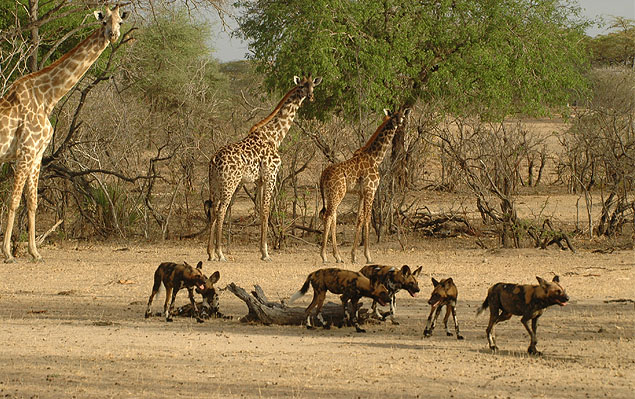Selous Game Reserve
Covering 45,000km² of wilderness, with grassy plains, open woodland, mountains and forests, the Selous Game Reserve is Africa’s largest game reserve. It’s about three times the size of South Africa’s Kruger National Park, and twice the size of the Serengeti National Park. In a fitting tribute, it is also one of Tanzania’s three World Heritage Sites.
Introduction to a Selous Safari
At the heart of the Selous Game Reserve, Tanzania’s largest river, the Rufiji, forms a complex network of channels, lakes and swamps that create one of the most outstanding ecological systems in East Africa. This river also splits the reserve into two different sections:
The northern Selous covers only around 5% of the reserve’s total area. No hunting is allowed here; this area is dedicated exclusively to photographic safaris. Virtually all of the small exclusive camps which we offer operate in this area.
The southern Selous, south of the Rufiji, is split up into a number of ‘hunting blocks’ – each of which typically cover about 1,000km². Ultimate Africa Expeditions doesn’t offer hunting safaris.
Access to the Selous Game Reserve
Getting to the Selous is easy, it is served by light aircraft flights from Dar and Ruaha daily – a flight takes about 45 minutes from Dar, and about 90 minutes from Ruaha.
History of the Selous
Selous is named in honour of the Englishman Frederick Courtney Selous, who lived and hunted in the region from 1871 for around forty years. He gained the reputation as the most accomplished hunter of his age and was also known for his writing, most notably he was the author of ‘A Hunter’s Wanderings in Africa’. Selous was the right-hand man to Cecil John Rhodes in his campaign to annex present-day Zimbabwe to the British Empire, he also achieved brief notoriety in 1899 for speaking out against England’s war on the Boer Republics of South Africa.
When the First World War broke out Selous, at the age of 60, was made Captain of the 25th Royal Fusiliers, winning a DSO in 1916. With his detailed knowledge of the bush, Selous led the chase after the German guerrilla army that presided in southern Tanzania. On New Year’s Day in 1917, Selous was shot dead by a sniper close to the banks of the Beho Beho River where he remains buried today, near Beho Beho Safari Camp.
Five years after Frederick Courtney Selous’ death, the British colonists incorporated a number of existing game reserves south of the river to extend the plains of the aptly named Selous. The Game Reserve reached its present size and shape in the 1940s, when the colonial government moved the remaining tribes out of the area to combat a sleeping sickness epidemic. It was inscribed as a UNESCO World Heritage Site in 1982.
Selous Safari Camps and Lodges
The Selous has a handful of low-key, eco-friendly; thatch-and- canvas lodges whose combined bed capacity amounts to little more than 300 visitors. The Selous is a game reserve and not subject to the regulations that govern Tanzania’s national parks, visitors are therefore offered a more integrated bush experience. All of the safari camps that we feature are within the reserve, with the exception of Sable Mountain Lodge, which is just outside the northern border of the reserve.
It is not uncommon to spend a whole day on a game drive without seeing another vehicle as the camps are spread out, and less than 1% of Tanzania’s visitors go to this region. This is particularly true if you are based at one of the western lodges such as Beho Beho. or Sand Rivers.
The best game viewing areas with the densest wildlife populations are found in the eastern parts of the reserve. Lake Manze Camp, Selous Impala Camp and Siwandu Camp, are known to be especially good for lion and wild dog sightings.
Note that the roads within the Selous become impassable after heavy rain. Hence camps here close towards the end of the wet season, in April, and re-open in June.
Activities in Selous
One of the main attractions of the Selous is the variety of game viewing activities available here. They all offer trips through the reserve by boat, vehicle and on foot. Boat safaris allow you to drift on the lakes and channels, approaching birds and animals closely, including crocodile and hippo. All of the lodges also offer guided game walks for those aged 12 and over (16 at Lake Manze and Impala), which come with a real likelihood of encountering big game such as; elephant, buffalo and even lion on foot. Game drives are reliably rewarding, especially towards the end of the dry season, when large mammals concentrate around the five lakes. Better still are the overnight fly-camping excursions offered by some of the camps, which entail sleeping out beneath a glorified mosquito net in the middle of the bush.
Animals
The prodigiously large mammal populations found here, support the claim that the Selous is the greatest surviving African wilderness. Buffalo numbers are estimated at 120,000–150,000, and the reserve’s 40,000 hippo and 4,000 lion are probably the largest such populations on the continent. The Selous also harbors an estimated 100,000 wildebeest, 35,000 zebra, 25,000 impala and significant herds of giraffe, greater kudu, waterbuck, bushbuck, Lichtenstein’s hartebeest and eland. It is also one of the most important sanctuaries in Africa for the endangered African wild dog, sable and puku antelope. A large proportion of Tanzania’s elephants are also found in the reserve as well as huge populations of crocodile, spotted hyena and leopard to name just a few of the big game species found here.
Birdlife
More than 440 bird species have been recorded in the Selous. On the lakes you’ll find pink-backed pelicans, African skimmers and giant kingfishers. The sandbanks are home to carmine and white-fronted bee-eater colonies whilst pairs of fish eagle, palmnut vulture, ibises and palm swifts nest in the borassus palms. Other waterbirds found in the Selous include: yellow-billed stork, white-crowned and spur-winged plovers, various small waders, pied and malachite kingfishers. Pairs of trumpeter hornbill and purple-crested turaco can also be seen between the riparian trees. Also worth looking out for among a catalogue of egrets and herons is the Malagasy squacco heron, a regular winter visitor, while the elusive Pel’s fishing owl often emerges at dusk to hawk above the water.

